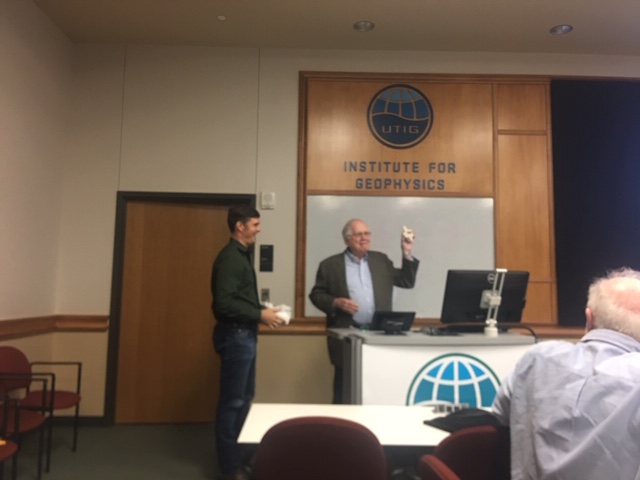Neogene Evolution of Central Texas Landscape after Balcones Faulting
Dr. Peter R. Rose
The Edwards Plateau and the Balcones Fault Zone (BFZ) dominate the geology and physiography of Central Texas. The Edwards Plateau was formed during Early Miocene time by uplift of the area west and north of the arcuate BFZ. The Albian Edwards Group was a continuous sheet of resistant shallow-shelf carbonate strata that covered all of central Texas: the Edwards Plateau, BFZ, and subsurface of the Central Texas Platform. At the time of first Balcones faulting, the Edwards was widely exposed west and north of the BFZ. Regional headward erosion and dissolution following Balcones faulting progressively stripped away Edwards strata, leaving steep, ragged bluffs that delineated the boundaries of the Edwards Plateau. Just as geological maps outline the Edwards Plateau today, a reconstruction of past Edwards Limestone outcrop locations records the stages of westward and northern erosional retreat through Miocene, Pliocene, Pleistocene and Holocene times.
This integrated geologic/geomorphic/hydrologic account is based upon three different categories of diagrams, prepared specifically for this paper:
A map showing the 26 drainage basins of central Texas;
Stream profiles of 12 rivers sourced from the Edwards Plateau Aquifer, in context with adjacent geologic boundaries of top (tKed) and base (bKed) of the Edwards Group, and base (bK) of Cretaceous formations within the map area;
Seven paleogeographic maps of the Edwards Plateau/BFZ area from onset of Balcones faulting (21 mya) to the present time, showing the location of the Edwards Plateau and the courses of all main streams, in 3.5 my stages.
The sequential evolution of the Central Texas landscape is integrated with independent evidence from five related geological processes and events to generate a holistic account of Edwards Plateau and BFZ history since early Miocene time:
Incised meanders of Edwards Plateau rivers and streams, inboard and peripheral to the BFZ, were probably inherited from early Paleocene conditions, then greatly amplified by Balcones-related uplift.
High porosity and permeability of Edwards strata in the central sector of the BFZ and Edwards Underground Aquifer is related to a) a longer period of increased stream gradients and stream piracy in that sector; b) a wider BFZ with greatest vertical displacement; and c) the presence of a major discharge point at the lowest elevation in the trend, at San Marcos Springs.
Between 14 and 10.5 mya, the Colorado River formed its Great Bend, when it shifted its course about 35 miles north and east, after eroding through Cretaceous strata, downward onto hard, northeast-dipping Paleozoic beds. This shift also generated the marked asymmetry of the Colorado drainage basin, with short tributaries on the east, and long straight tributaries on the west.
Multiple levels of horizontal cave development (youngest downward) in the western Edwards Plateau suggest that the thickness of the Edwards Plateau aquifer was greatest immediately following Balcones faulting, and declined afterward in stages as erosion reduced the area of surface recharge, and increased outflows.
The post-Balcones Medina Arch induced concave-upward stream profiles in streams originating around its apex: Pedernales, Blanco, Guadalupe, Medina, Frio, and East Nueces Rivers.
Biography
Dr. Pete Rose (Ph. D., Geology, University of Texas, Austin) has been a professional geologist for 59 years, specializing in Carbonate Stratigraphy, Petroleum Geology, E&P Risk Analysis, and Mineral Economics. Before going on his own in 1980 as an independent prospector and consultant, he worked for Shell Oil Company, the United States Geological Survey, and Energy Reserves Group, Inc, a small-cap Independent.
After 10 years as an internationally-recognized authority on economic risking of exploration drilling ventures, he founded Rose & Associates, LLP, in 1998. His 2001 book, Risk Analysis and Management of Petroleum Exploration Ventures, now in its 7th printing, is considered by many as the “Bible” on that topic, and has been translated into Chinese, Japanese, and Russian. Pete retired in 2005; Rose and Associates LLP continues as the global standard among consulting companies in that field, providing instruction, software and consulting services on an international scale.
Pete wrote the definitive geological monograph on the Edwards Limestone of Texas (Rose, 1972), and has continued related investigations to the present time -- this will be his 10th published paper on various aspects of the Edwards Plateau area. He has authored or co-authored more than 80 published articles on an extremely wide variety of geological topics. He was a Fellow of the Geological Society of America, the American Association for the Advancement of Science, and Geological Society of London.
In 2005 he was the 89th President of the American Association of Petroleum Geologists, In 2006-07 he was deeply involved in successful efforts to encourage the U. S. Securities and Exchange Commission to modernize its rules governing estimation and disclosure of oil and gas reserves, thus facilitating the investment component of the “shale revolution” in the U. S. Pete ws President of the Austin geological Society in 2012/13.
In 2013, the Geological Society of London awarded Peter R. Rose its prestigious Petroleum Group Medal for lifetime contributions to Petroleum Geology, the first American to be so recognized, and in 2014 the American Association of Petroleum Geologists honored him with its Halbouty Outstanding Leadership Award.


